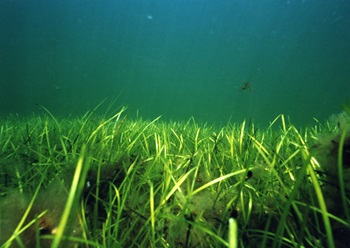
We have been involved in an extensive research project: ‘Key parameters and processes affecting the re-establishment of eelgrass in estuaries and coastal waters’ or in short, ‘The Reelgrass Project’. Various attempts have been made to establish new colonies of eelgrass in degraded meadows – often unsuccessful. We contributed by implementing the other project partner’s experimental findings in an ecological model, which was set up on 3 lagoon systems. The model is able to mimic the present status of the eelgrass vegetation and the potential recovery, provided some of the newly identified stressors for eelgrass growth are removed.
Eelgrass beds are widespread through the northern areas of the Northern Hemisphere. They serve as a substrate for important benthic fauna and serve as nursery grounds for many species of ecologically important fish and shellfish. Physically, the eelgrass meadows stabilise the sediment and serve as deposition areas for fine sediments. Thus, eelgrass meadows are an important ecological element of estuarine and temperate coastal waters.
Over the last decades, eelgrass vegetation cover has declined significantly – especially in European and Northern American waters. The Reelgrass project has focused on identifying some of the so far unknown or un-quantified stressors and feedback mechanisms for eelgrass growth. In doing so, the aim of the project was to examine why eelgrass doesn’t re-colonize former meadows mainly destroyed by eutrophication, many years after the nutrient load has declined.
A two string approach was adopted for the project:
• Development of a comprehensive Hydro-Ecological model describing the eelgrass meadows.
• A more management-oriented GIS-based model identifying potential areas for eelgrass re-establishment. The GIS-based model partly uses model outputs and partly monitoring data as input.
The project findings have improved the understanding of the mechanisms inhibiting eelgrass re-colonization in temperate regions worldwide. They will be presented in an upcoming event, ‘Congress: Restoration of eelgrass in marine areas, seen in management perspective.’
Dr. Orth – a leading expert in the field of eelgrass restoration will present a successful restoration of former eelgrass vegetation in a North American lagoon. This will open a discussion on the international perspectives about the subject, as well.
We invite you to participate in the
Congress. It will be held at the University of Southern Denmark Odense on 15-16 November 2012.